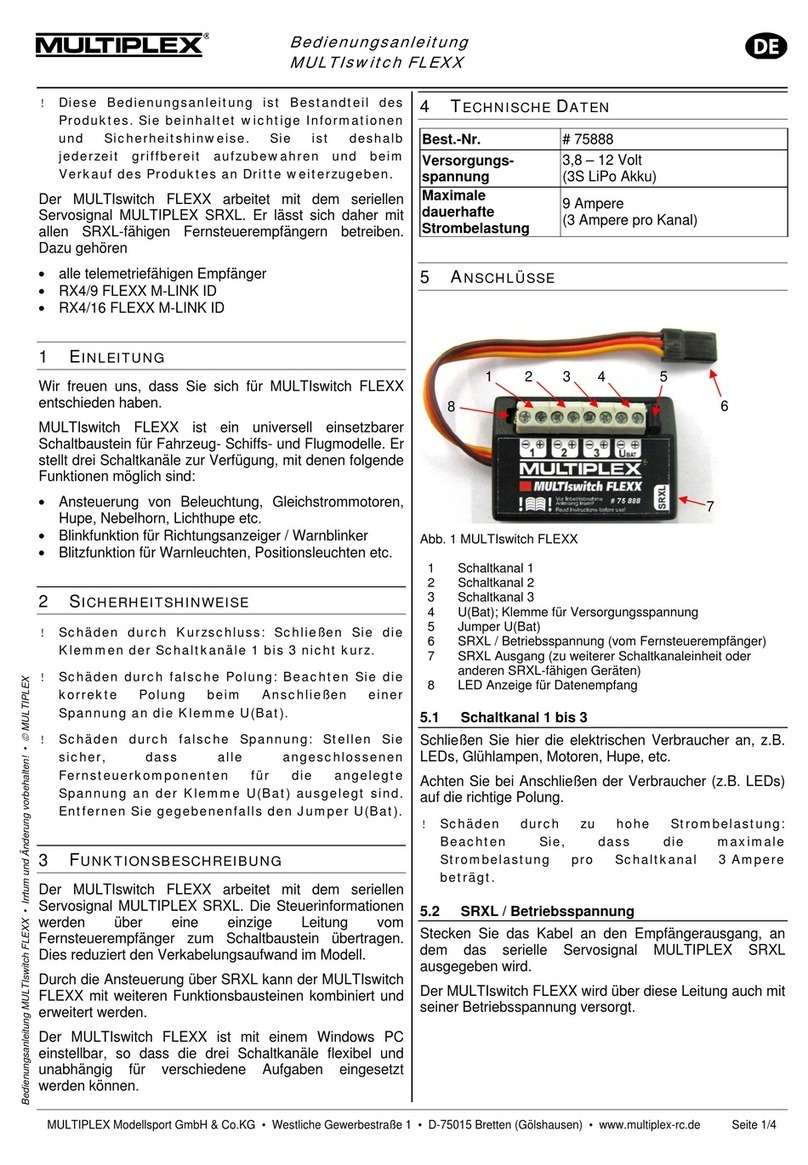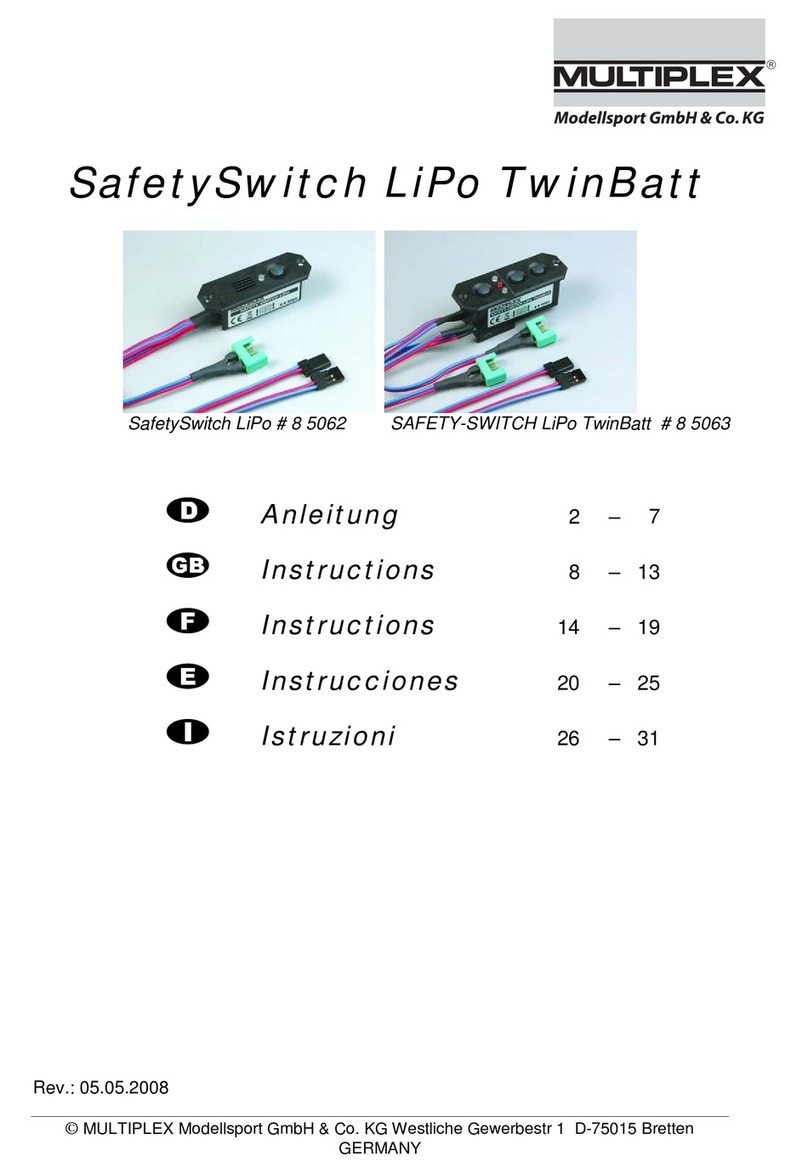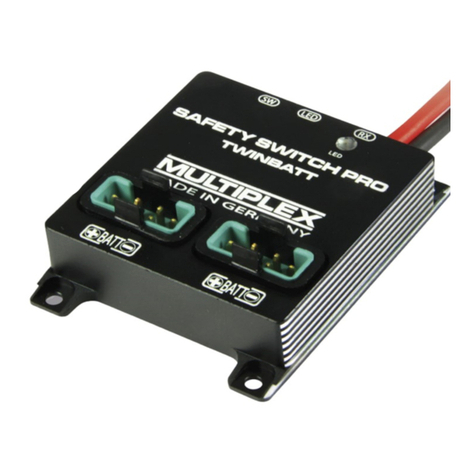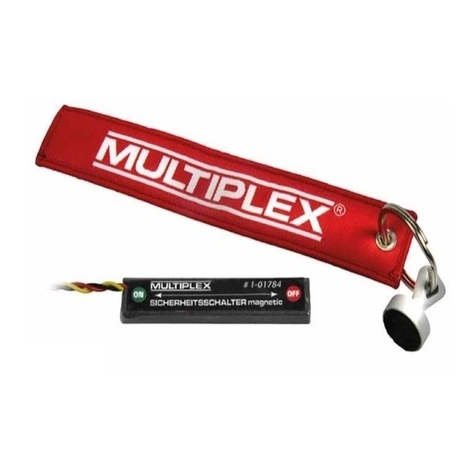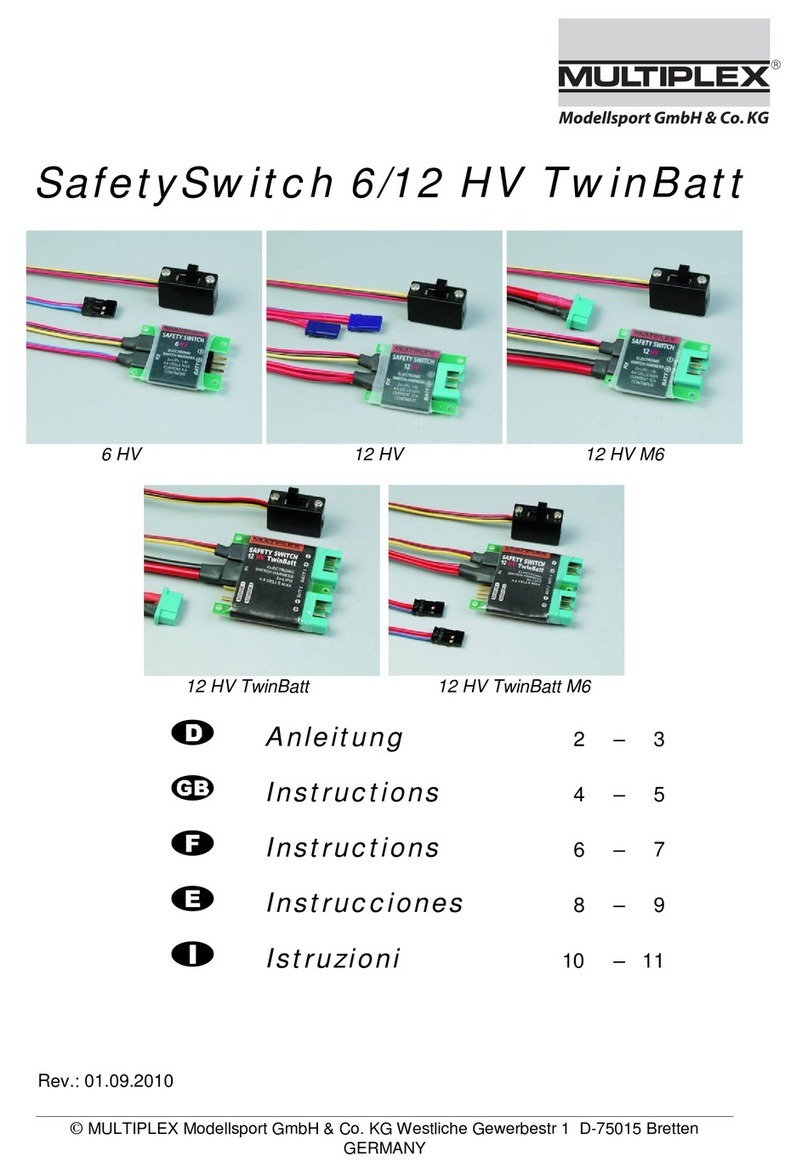
Operating instructions for AntiFlash 70,
“Micro” and “Professional” safety switch
MULTIPLEX Modellsport GmbH & Co.KG • Westliche Gewerbestraße 1 • D-75015 Bretten (Gölshausen) • www.multiplex-rc.de Page 2/4
Instructions for AntiFlash 70, “Micro” and “Professional” safety switch # 82 5496 (10-10-20/MIWA) • Errors and omissions excepted. •
MULTIPLEX
1, fit heat-shrink sleeves and attach your preferred connector
system to the bare ends.
xLocate the end of the AntiFlash 70 marked ESC (to the
speed controller) in Fig. 1, and attach the two wires. Fit heat-
shrink sleeves, and solder your preferred connector system
to the bare ends. Fig. 2 shows the result of this procedure.
Alternatively:
Solder the positive and negative wires from the speed
controller directly to the AntiFlash 70, and insulate the solder
joints with heat-shrink sleeves.
!Caution: when soldering the joints it is absolutely
essential to maintain correct polarity at both the battery
and the speed controller ends!
xPlace the paper label on the AntiFlash 70, referring to Figs. 1
and 3, noting in particular the position of the pre-cut hole in
the paper label. Slip the heat-shrink sleeve over the paper
label, and carefully apply a heat-gun to shrink the sleeve in
place. The result is shown in Fig. 3.
!Caution: do not subject the AntiFlash 70 to excessive
heat when shrinking the heat-shrink sleeve!
xIf you also intend to use one of the two safety switches
(“Micro” or “Professional”) (Î4.): use a sharp knife to cut
away the heat-shrink sleeve over the socket marked “Switch”
on the edge of the AntiFlash 70 (Fig. 3).
The system in use:
1) Connect the ESC end of the AntiFlash 70 (unless you have
soldered the controller leads directly to the AntiFlash 70).
2) Switch the transmitter ON.
3) If the receiver is powered by one or more separate receiver
batteries: switch the receiving system ON.
4) Connect the flight battery to the BATT end of the AntiFlash
70.
Result:
The power system is now “armed” without any sparking, and the
motor can be started. Caution - injury hazard: the receiving
system is active, and the motor could start running.
5) After the flight: disconnect the flight battery from the
AntiFlash 70. If you are using separate receiver batteries,
switch the receiving system OFF. Finally switch the trans-
mitter OFF.
5.2 AntiFlash 70 with M6 connector system
Preparation:
xIf you also intend to use one of the two safety switches
(“Micro” or “Professional”) (Î4.): use a sharp knife to cut
away the heat-shrink sleeve over the socket marked “Switch”
on the edge of the AntiFlash 70 (Fig. 3).
The system in use:
1) Connect the speed controller to the ESC end of the Anti-
Flash 70.
2) Switch the transmitter ON.
3) If the receiver is powered by one or more separate receiver
batteries: switch the receiving system ON.
4) Connect the flight battery to the BATT end of the Anti-
Flash 70.
Result:
The power system is now “armed” without any sparking, and the
motor can be started. Caution - injury hazard: the receiving
system is active, and the motor could start running.
5) After the flight: disconnect the flight battery from the
AntiFlash 70. If you are using separate receiver batteries,
switch the receiving system OFF. Finally switch the trans-
mitter OFF.
6. MICRO SAFETY SWITCH:
INSTALLATION /THE SYSTEM IN USE
Installation:
xDecide on a suitable location on the model for the Micro
safety switch. It is particularly important that there is no
chance of operating the switch accidentally.
xRemove the switch bezel (Torx T6 screws) and place it on
the model in the location you have selected.
xMark on the model the position of the screw-holes and the
rectangular opening, using the switch bezel as a template.
Remove the bezel, drill the holes 2.5 mm Ø, and cut out the
10 x 5 mm slot for the switch slider.
xFit the Micro safety switch from the inside / from the rear,
place the bezel on the front, and fit the retaining screws.
xConnect the cable attached to the Micro safety switch to the
vacant socket on the edge of the AntiFlash 70 (marked
“Switch”; see Fig. 4).
The system in use:
1) Move the switch slider to the OFF position, as shown in Fig.
5, i.e. with the knob pointing “away from the switch lead”.
2) Connect the ESC end of the AntiFlash 70 (unless you have
soldered the controller cables directly to the AntiFlash 70).
3) Switch the transmitter ON.
4) If the receiver is powered by one or more separate receiver
batteries: switch the receiving system ON.
5) Connect the flight battery to the BATT end of the AntiFlash
70. The motor cannot be started yet.
6) Move the slide switch to the ON position, as shown in Fig. 5,
i.e. with the knob pointing “towards the switch lead”.
Result:
The power system is now “armed” without any sparking, and the
motor can be started. Caution - injury hazard: the receiving
system is active, and the motor could start running.
7) After the flight: move the slide switch to the OFF position,
then disconnect the flight battery from the AntiFlash 70. If
you are using separate receiver batteries, switch the
receiving system OFF. Finally switch the transmitter OFF.
7. PROFESSIONAL SAFETY SWITCH:
INSTALLATION /THE SYSTEM IN USE
Installation:
xDecide on a suitable location on the model for the
Professional safety switch. Since the unit features a
magnetic actuator, the unit should be kept as far away as
possible from electro-magnetic fields such as the motor.
xCut a 15 mm Ø hole at this point, fit the Professional safety
switch through the hole from the outside, and mark on the
model the position of the five screw-holes. Remove the
Professional safety switch again and drill the five holes 2.5
mm Ø. Place the Professional safety switch in the hole once
more, and fix it to the model using M2 machine-screws, M2
nuts and washers.
xConnect the cable attached to the Professional safety switch
to the vacant socket on the edge of the AntiFlash 70 (marked
“Switch”; see Fig. 4).
The system in use:
1) Place the red magnet (with MULTIPLEX pennant) on the
Professional safety switch.
2) Connect the ESC end of the AntiFlash 70 (unless you have
soldered the controller cables directly to the AntiFlash 70).












